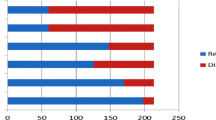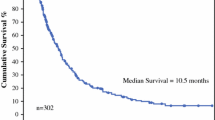Abstract
Objectives
Our aim was to provide further evidence for the efficacy/safety of radioembolization using yttrium-90-resin microspheres for unresectable chemorefractory liver metastases from colorectal cancer (mCRC).
Methods
We followed 104 consecutively treated patients until death. Overall survival (OS) was calculated from the day of the first radioembolization procedure. Response was defined by changes in tumour volume as defined by Response Evaluation Criteria in Solid Tumours (RECIST) v1.0 and/or a ≥30 % reduction in serum carcinoembryonic antigen (CEA) at 3 months.
Results
Survival varied between 23 months in patients who had a complete response to prior chemotherapy and 13 months in patients with a partial response or stable disease. Median OS also significantly improved (from 5.8 months to 17.1 months) if response durability to radioembolization extended beyond 6 months. Patients with a positive trend in CEA serum levels (≥30 % reduction) at 3 months post-radioembolization also had a survival advantage compared with those who did not: 15.0 vs 6.7 months. Radioembolization was well tolerated. Grade 3 increases in bilirubin were reported in 5.0 % of patients at 3 months postprocedure.
Conclusions
After multiple chemotherapies, many patients still have a good performance status and are eligible for radioembolization. This single procedure can achieve meaningful survivals and is generally well tolerated.
Key Points
• After multiple chemotherapies, many patients are still eligible for radioembolization (RE).
• RE can achieve meaningful survival in patients with chemorefractory liver-predominant metastatic colorectal cancer (mCRC).
• Tumour responsiveness to prior systemic treatments is a significant determinant of overall survival (OS) after RE.
• Radioembolization in patients with a good performance status is generally well tolerated.

Similar content being viewed by others
References
IARC IAfRoC (2014) GLOBOCAN: estimated incidence, mortality and prevalence worldwide in 2012 (population fact sheet in more developed countries). Copyright: IARC, Lyon, France. http://globocan.iarc.fr/Pages/fact_sheets_population.aspx. Last accessed January 2014
Cartwright TH (2012) Treatment decisions after diagnosis of metastatic colorectal cancer. Clin Colorectal Cancer 11:155–166
Elferink MA, de Jong KP, Klaase JM, Siemerink EJ, de Wilt JH (2015) Metachronous metastases from colorectal cancer: a population-based study in North-East Netherlands. Int J Color Dis 30:205–212
Ribero D, Vigano L, Amisano M, Capussotti L (2013) Prognostic factors after resection of colorectal liver metastases: from morphology to biology. Future Oncol 9:45–57
Clark ME, Smith RR (2014) Liver-directed therapies in metastatic colorectal cancer. J Gastrointest Oncol 5:374–387
Mi K, Kalady MF, Quintini C, Khorana AA (2015) Integrating systemic and surgical approaches to treating metastatic colorectal cancer. Surg Oncol Clin N Am 24:199–214
Fiorentini G, Aliberti C, Mulazzani L et al (2014) Chemoembolization in colorectal liver metastases: the rebirth. Anticancer Res 34:575–584
Liu DM, Thakor A, Baerlocher M et al (2015) A review of conventional and drug-eluting chemoembolization in the treatment of colorectal liver metastases: principles and proof. Future Oncology (London, England). doi:10.2217/fon.15.3:1-8
Fiorentini G, Aliberti C, Tilli M et al (2012) Intra-arterial infusion of irinotecan-loaded drug-eluting beads (DEBIRI) versus intravenous therapy (FOLFIRI) for hepatic metastases from colorectal cancer: final results of a phase III study. Anticancer Res 32:1387–1395
de Baere T, Tselikas L, Pearson E et al (2015) Interventional oncology for liver and lung metastases from colorectal cancer: the current state of the art. Diagn Interv Imaging. doi:10.1016/j.diii.2015.04.004
Hendlisz A, Van den Eynde M, Peeters M et al (2010) Phase III trial comparing protracted intravenous fluorouracil infusion alone or with yttrium-90 resin microspheres radioembolization for liver-limited metastatic colorectal cancer refractory to standard chemotherapy. J Clin Oncol 28:3687–3694
Van Hazel G, Blackwell A, Anderson J et al (2004) Randomised phase 2 trial of SIR-Spheres plus fluorouracil/leucovorin chemotherapy versus fluorouracil/leucovorin chemotherapy alone in advanced colorectal cancer. J Surg Oncol 88:78–85
Kennedy AS (2014) Radiation oncology approaches in liver malignancies. Am Soc Clin Oncol Educ Book e150–e155. doi:10.14694/EdBook_AM.2014.34.e150
Van Cutsem E, Cervantes A, Nordlinger B, Arnold D (2014) Metastatic colorectal cancer: ESMO Clinical Practice Guidelines for diagnosis, treatment and follow-up. Ann Oncol 25:iii1–iii9
Ahmadzadehfar H, Biersack HJ, Ezziddin S (2010) Radioembolization of liver tumors with yttrium-90 microspheres. Semin Nucl Med 40:105–121
Jakobs TF, Hoffmann RT, Tatsch K, Trumm C, Reiser MF, Helmberger TK (2007) Developments and perspectives in radioablative techniques. Radiologe 47:1083–1088
Institute NC (2006) Common terminology criteria for adverse events v3.0. http://ctep.cancer.gov/protocolDevelopment/electronic_applications/ctc.htm
Chalian H, Tore HG, Horowitz JM, Salem R, Miller FH, Yaghmai V (2011) Radiologic assessment of response to therapy: comparison of RECIST Versions 1.1 and 1.0. Radiographics 31:2093–2105
Kennedy AS, Coldwell D, Nutting C et al (2006) Resin 90Y-microsphere brachytherapy for unresectable colorectal liver metastases: modern USA experience. Int J Radiat Oncol Biol Phys 65:412–425
Kennedy A, Ball D, Cohen Sea (2013) Safety and efficacy of resin 90Y-microspheres in 548 patients with colorectal liver metastases progressing on systemic chemotherapy. ASCO Gastrointestinal Cancers Symposium:Abs. 264
Cosimelli M, Golfieri R, Pennington B, Sennfält K (2013) Selective internal radiotherapy (SIRT) using resin yttrium-90 resin microspheres for chemotherapy-refractory metastatic colorectal cancer: an Italian cost-effectiveness analysis. Value Health 16:A409
Saxena A, Meteling B, Kapoor J, Golani S, Morris DL, Bester L (2015) Is yttrium-90 radioembolization a viable treatment option for unresectable, chemorefractory colorectal cancer liver metastases? A large single-center experience of 302 patients. Ann Surg Oncol 22:794–802
Chapiro J, Duran R, Lin M et al (2015) Early survival prediction after intra-arterial therapies: a 3D quantitative MRI assessment of tumor response after TACE or radioembolization of colorectal cancer metastases to the liver. Eur Radiol 25:1993–2003
Hipps D, Ausania F, Manas DM, Rose JD, French JJ (2013) Selective Interarterial Radiation Therapy (SIRT) in colorectal liver metastases: how do we monitor response? HPB Surg 2013:570808
Fendler WP, Ilhan H, Paprottka PM et al (2015) Nomogram including pretherapeutic parameters for prediction of survival after SIRT of hepatic metastases from colorectal cancer. Eur Radiol 25:2693–2700
Dixon MR, Haukoos JS, Udani SM et al (2003) Carcinoembryonic antigen and albumin predict survival in patients with advanced colon and rectal cancer. Arch Surg 138:962–966
Graf W, Bergstrom R, Pahlman L, Glimelius B (1994) Appraisal of a model for prediction of prognosis in advanced colorectal cancer. Eur J Cancer 30a:453–457
Maisano R, Azzarello D, Del Medico P et al (2011) Alkaline phosphatase levels as a prognostic factor in metastatic colorectal cancer treated with the FOLFOX 4 regimen: a monoinstitutional retrospective study. Tumori 97:39–42
Kennedy AS, Ball D, Cohen SJ et al (2015) Multicenter evaluation of the safety and efficacy of radioembolization in patients with unresectable colorectal liver metastases selected as candidates for (90)Y resin microspheres. J Gastrointest Oncol 6:134–142
Aliberti C, Fiorentini G, Muzzio PC et al (2011) Trans-arterial chemoembolization of metastatic colorectal carcinoma to the liver adopting DC Bead(R), drug-eluting bead loaded with irinotecan: results of a phase II clinical study. Anticancer Res 31:4581–4587
Martin RC, Joshi J, Robbins K et al (2011) Hepatic intra-arterial injection of drug-eluting bead, irinotecan (DEBIRI) in unresectable colorectal liver metastases refractory to systemic chemotherapy: results of multi-institutional study. Ann Surg Oncol 18:192–198
Stutz M, Mamo A, Valenti D et al (2015) Real-life report on chemoembolization using DEBIRI for liver metastases from colorectal cancer. Gastroenterol Res Pract 2015:715102
Acknowledgments
The scientific guarantor of this publication is PD Dr. med. Tobias Jakobs. The authors of this manuscript declare no relationships with any companies, whose products or services may be related to the subject matter of the article. The authors state that this work has not received any funding.
Prof. Wieland Sommer (MPH) kindly provided statistical advice for this manuscript. Institutional Review Board approval was obtained. Written informed consent was obtained from all patients. Methodology: retrospective, observational, performed at one institution.
Author information
Authors and Affiliations
Corresponding author
Additional information
T. F. Jakobs and K. J. Paprottka contributed equally to this work.
Rights and permissions
About this article
Cite this article
Jakobs, T.F., Paprottka, K.J., Raeßler, F. et al. Robust evidence for long-term survival with 90Y radioembolization in chemorefractory liver-predominant metastatic colorectal cancer. Eur Radiol 27, 113–119 (2017). https://doi.org/10.1007/s00330-016-4345-z
Received:
Revised:
Accepted:
Published:
Issue Date:
DOI: https://doi.org/10.1007/s00330-016-4345-z




